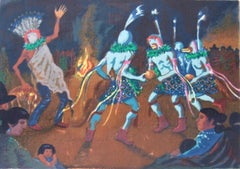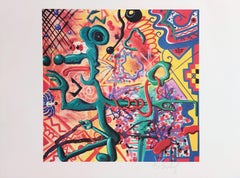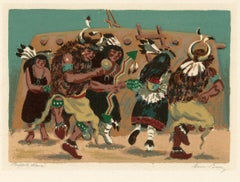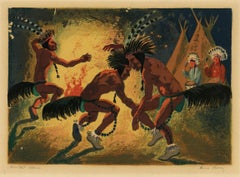Anna Barry Figurative Prints
to
1
Overall Width
to
Overall Height
to
1
2
859
382
371
308
1
1
1
1
1
1
1
1
Artist: Anna Barry
Anna Barry, Navajo Yei Bei Chai
By Anna Barry
Located in New York, NY
Anna Barry (1907-2001), and her husband, the artist Ira Moskovitz, spent years in New Mexico in the late 1930s and 40s. They returned permanently to New York City in 1949.
The screen print (also known as silk screen or serigraph) Navajo Yei...
Category
Mid-20th Century American Modern Anna Barry Figurative Prints
Materials
Screen
Related Items
Headstand (San Francisco Museum of Modern Art) - Exhibition Poster
By Keith Haring
Located in Paris, IDF
Keith Haring
Headstand
Original vintage exhibition Poster printed in Screenprint
On thick paper
90 x 60 cm (c. 36 x 24 in)
INFORMATION: Official screenprint poster for the Haring e...
Category
1980s American Modern Anna Barry Figurative Prints
Materials
Screen
Ratfinkbonerthunk : Surrealist Rat - Original Giclee Print, Handsigned
By Kenny Scharf
Located in Paris, IDF
Kenny Scharf
Ratfinkbonerthunk : Surrealist Rat, 1990
Original Giclee Print
Handsigned in pencil
On Arches vellum 56 x 76 cm (c. 22 x 30 in)
Published by Editions Vermorel in 1990
...
Category
1990s American Modern Anna Barry Figurative Prints
Materials
Giclée, Screen
$1,762
H 22.05 in W 29.93 in
Original Mardi Gras New Orleans 1978 festival serigraph poster
Located in Spokane, WA
Original Mardi Gras, New Orleans, 1978 linen-backed poster. Dressed up in what would be an American Indian costume with full headgear, he is holding a shield with a horse on it. Indian decoration on the footwear. Signed and numbered.
I believe this has to deal with Big Chief leading his Congo Nation Mardi Gras Indian group. Zulu Parade. Many of the original Mardi Gras jazz posters...
Category
1970s American Modern Anna Barry Figurative Prints
Materials
Screen
$636 Sale Price
20% Off
H 32 in W 23 in D 0.05 in
Modernist Figurative Pop Art Etching and Aquatint "the Artist" Michael Mazur
By Michael Mazur
Located in Surfside, FL
Michael Mazur
"The Artist"
Hand signed and editioned from the edition of 50
1967
Michael Burton Mazur (1935-August 18, 2009) was an American artist who was described by William Grim...
Category
Early 2000s American Modern Anna Barry Figurative Prints
Materials
Lithograph, Screen
"Balcony" 1938 WPA Print Mid 20th Century American Broadway Theatre Modernism
By Leon Bibel
Located in New York, NY
"Balcony" 1938 WPA Print Mid 20th Century American Broadway Theatre Modernism.
Silk screen on paper, 15” x 20". Numbered 15/20 lower left. Pencil si...
Category
1930s American Modern Anna Barry Figurative Prints
Materials
Paper, Screen
Original Continental Airlines limited edition Serigraph vintage travel poster
Located in Spokane, WA
Original Continental Airlines travel poster. Linen backed in fine condition. Signed and numbered 35/50.
This original Continental Airlines poster is an artistic representation of regional destinations prominently served by Continental Airlines in the past. The design is modern and bold, showcasing a unique black-and-white theme with strong, futuristic typography and graphical illustrations. Each city is creatively depicted using stylized imagery that resonates with its character—Oklahoma City features a cowboy motif, New Orleans embraces a jazzy, cultural essence, Dallas reflects the energy of movement, and Midland/Odessa highlights industrial and oil-centric themes.
This limited-edition poster is printed in black and white. It features the destinations of Hawaii, San Francisco, Albuquerque and Portland Above each name is a design that represents each destination city.
Hawaii has rows of palm trees and hula dancers. San Francisco has rolling hills and cable cars. Albuquerque has tribal Indians dancing. Portland has the cruise shipping. This image features the Saul Bass l967 Continental logo in the design.
Continental Airlines was a major United States airline founded in 1934 and eventually headquartered in Houston, Texas.
The airline was acquired by UAL Corporation, the parent company of United Airlines, on October 1, 2010.
This is an original vintage Continental Airlines poster...
Category
Late 20th Century American Modern Anna Barry Figurative Prints
Materials
Screen
$675
H 40 in W 26.5 in D 0.3 in
Hilaire Hiler 1934 WPA Era Color Serigraph – Native American Fox Costume Art
By Hilaire Hiler
Located in Denver, CO
This vibrant 1934 vintage color serigraph (silkscreen print) by acclaimed artist Hilaire Hiler (1898–1966) depicts a stylized Native American figure dressed in a fox costume holding a bow, featuring a bold feather headdress and striking contrasts of black, red, and white. Created during the influential WPA era, this modernist print reflects Hiler’s semi-abstract approach to Native American themes, blending cultural symbolism with avant-garde color theory.
Signed in pencil by Hiler in the lower right margin and titled on the verso, this serigraph is a rare and evocative example of early 20th-century American modernism.
About Hilaire Hiler:
Born in St. Paul, Minnesota, Hiler studied at the University of Paris and the Pennsylvania Academy of the Fine Arts before immersing himself in the European avant-garde scene. He supported his art career by performing as a jazz musician in Paris.
Returning to the U.S. in 1934, Hiler contributed murals to the WPA Aquatic Park...
Category
1930s American Modern Anna Barry Figurative Prints
Materials
Screen
$2,450
H 17.5 in W 15 in D 1.5 in
Black Break, Screenprint by LeRoy Neiman
By LeRoy Neiman
Located in Long Island City, NY
Artist: LeRoy Neiman, American (1921 - 2012)
Title: Black Break
Year: 1973
Medium: Screenprint, signed and numbered in pencil
Edition: AP, 300
Size: 26 in. x 20.2 in. (66.04 cm x 51...
Category
1970s American Modern Anna Barry Figurative Prints
Materials
Screen
Flowers - Original Screen Print - Handsigned and /100 (Schellman II.101)
By Andy Warhol
Located in Paris, IDF
Andy Warhol (1928-1987)
Flowers (black and white), 1986
Original silkscreen (Printer Alexander Heinrichi, New York)
Signed in pencil with the monogram lower right
Countersigned in p...
Category
1980s American Modern Anna Barry Figurative Prints
Materials
Screen
$10,574
H 40.56 in W 27.17 in
Jacques Monory - In Honor of Oklahoma's War Heroes, Original Screenprint SIGNED
By Jacques Monory
Located in Paris, IDF
Jacques Monory
In Honor of Oklahama's War Heroes, 1976
Original screen print
Handsigned
On BFK Rives 38 x 28 cm (c. 14x 11 in)
Limited to 300 exemplary, not numbered
INFORMATION: ...
Category
1970s American Modern Anna Barry Figurative Prints
Materials
Screen
$352
H 14.97 in W 11.03 in
Vintage Poster Saul Steinberg Galerie Maeght Paris France
By Saul Steinberg
Located in Surfside, FL
SAUL STEINBERG (American 1914-1999) Via Air Mail Geometric Design Lithograph. Sheet: 21 1/2 x 28 inches; Frame: 22 1/4 x 29 inches. Plate signed and dated l/r with sticker upper ri...
Category
1970s American Modern Anna Barry Figurative Prints
Materials
Screen
Original "Wagon Lits" pop art style serigraph travel by train poster
By Valerio Adami
Located in Spokane, WA
Original “Wagon Lits” serigraph poster by the artist Valerio Adami.
It was printed in France by GrafiCaza (Michel Caza), one of the finest serigraph companies on woven paper—in exce...
Category
1990s American Modern Anna Barry Figurative Prints
Materials
Screen
$260 Sale Price
20% Off
H 36 in W 24 in D 0.05 in
Previously Available Items
Buffalo Dance
By Anna Barry
Located in Fairlawn, OH
Buffalo Dance
Screen print, c. 1945
Signed and titled in pencil by the artist (see photos)
The Buffalo Dance is a ceremonial dance performed by Native American tribes in the North Am...
Category
1940s American Modern Anna Barry Figurative Prints
Materials
Screen
Horse Tail Dance
By Anna Barry
Located in Fairlawn, OH
Signed and titled in pencil by the artist
Anna Barry was the wife of the noted Polish/American artist Ira Moskowitz (b. 1912)
Image: 5 1/8 x 7 1/4"
Category
1940s Anna Barry Figurative Prints
Materials
Screen
Anna Barry figurative prints for sale on 1stDibs.
Find a wide variety of authentic Anna Barry figurative prints available for sale on 1stDibs. You can also browse by medium to find art by Anna Barry in screen print and more. Much of the original work by this artist or collective was created during the 20th century and is mostly associated with the modern style. Not every interior allows for large Anna Barry figurative prints, so small editions measuring 7 inches across are available. Customers who are interested in this artist might also find the work of Bernard Brussel-Smith, Samuel Chamberlain, and Lynd Ward. Anna Barry figurative prints prices can differ depending upon medium, time period and other attributes. On 1stDibs, the price for these items starts at $600 and tops out at $600, while the average work can sell for $600.



